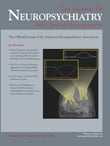Modafinil-Induced Orofacial Dyskinesia in an Elderly Patient With Refractory Bipolar Depression
To the Editor: Excessive sleepiness and fatigue are common features of bipolar depression. Various augmentation strategies have been employed including atypical antipsychotics and anticonvulsants with varying degrees of efficacy. Recently, modafinil, a stimulant, typically prescribed for excessive daytime sleepiness, 1 has shown some efficacy as an adjunctive treatment in bipolar depression. 2
Case Report
A 74-year-old man with a long history of treatment-refractory bipolar I disorder, rapid-cycling subtype, and multiple medical problems, including chronic renal failure secondary to type II diabetes and lithium (CrCl=26 ml/min on admission), presented with severe depressive symptoms. Psychotropic medications on admission included quetiapine, 200 mg at bedtime, venlafaxine XR, 225 mg/day, and lamotrigine, 100 mg b.i.d. Prior to the introduction of modafinil, the patient displayed severe psychomotor retardation and was socially isolated. Modafinil was initiated at 50 mg/day and titrated by 50 mg/day every 10 days. The medication was well tolerated with no reported side effects; liver function tests were normal at baseline and throughout treatment.
Clinical improvement was noted on day 12 of therapy at a dose of 100 mg/day. He started attending occupational therapy groups, exercising on the stationary bike, and meeting with the treatment team. This remarkable turnaround lasted until day 19 before the patient’s mood began to drop and fatigue returned. The dose was increased to 150 mg/day on day 20 and then to 200 mg/day on day 30, with no effect. On day 44, the patient presented with an acute change in mental state (disorientation, fluctuating course) and orofacial dyskinesias. These movements primarily affected the lips, perioral area, jaw, and tongue. The patient was aware of the movements and was distressed by their presence. This occurred in the context of severe constipation (no bowel movement in 14 days) and urinary retention requiring repeated in and out catheterization. After a rigorous bowel routine, hydration, and discontinuation of modafinil, the orofacial movements resolved completely by day 53.
Discussion
We believe the patient’s multiple medical problems at the time led to reduced clearance of modafinil which is metabolized by the liver and predominantly excreted in the urine. The timeline outlined supports a causal relationship between modafinil and the development of the orofacial dyskinesias. The symptoms resolved quickly after discontinuation of the medication and resolution of the bowel and bladder dysfunction. There is evidence that D 1 and D 2 receptors are targeted by modafinil. 3 This presentation is remarkably similar to previous cases of orofacial dyskinesia reported in patients receiving modafinil 1 , 4 and adrafinil. 5 Patients with impaired elimination of modafinil may be susceptible to developing dyskinesias.
1. Anderson KN, Pilsworth S, Sharples LD, et al: Idiopathic hypersomnia: a study of 77 cases. Sleep 2007; 30:1274–1281Google Scholar
2. Frye MA, Grunze H, Suppes T, et al: A placebo-controlled evaluation of adjunctive modafinil in the treatment of bipolar depression. Am J Psychiatry 2007; 164:1242–1249Google Scholar
3. Young JW: Dopamine D 1 and D 2 receptor family contributions to modafinil-induced wakefulness. J Neurosci 2009; 29:2663–2665 Google Scholar
4. Luborzewski A, Regen F, Schindler F, et al: Modafinil-induced reversible hyperkinetic nondystonic movement disorder in a patient with major depressive disorder. J Neuropsychiatry Clin Neurosci 2006; 18:248–249Google Scholar
5. Thobois S, Xie J, Mollion H, et al: Adrafinil-induced orofacial dyskinesia. Mov Disord 2004; 19:965–966Google Scholar



